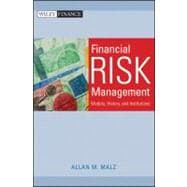
Note: Supplemental materials are not guaranteed with Rental or Used book purchases.
Purchase Benefits
What is included with this book?
| List of Figures | p. xvii |
| Preface | p. xxi |
| Financial Risk in a Crisis-Prone World | p. 1 |
| Some History: Why Is Risk a Separate Discipline Today? | p. 1 |
| The Scope of Financial Risk | p. 34 |
| Market Risk Basics | p. 43 |
| Arithmetic, Geometric, and Logarithmic Security Returns | p. 44 |
| Risk and Securities Prices: The Standard Asset Pricing Model | p. 49 |
| The Standard Asset Distribution Model | p. 63 |
| Portfolio Risk in the Standard Model | p. 75 |
| Benchmark Interest Rates | p. 88 |
| Value-at-Risk | p. 93 |
| Definition of Value-at-Risk | p. 94 |
| Volatility Estimation | p. 99 |
| Modes of Computation | p. 108 |
| Short Positions | p. 113 |
| Expected Shortfall | p. 114 |
| Nonlinear Risks and the Treatment of Bonds and Options | p. 119 |
| Nonlinear Risk Measurement and Options | p. 121 |
| Yield Curve Risk | p. 136 |
| VaR for Default-Free Fixed Income Securities Using The Duration and Convexity Mapping | p. 148 |
| Portfolio VaR for Market Risk | p. 159 |
| The Covariance and Correlation Matrices | p. 160 |
| Mapping and Treatment of Bonds and Options | p. 162 |
| Delta-Normal VaR | p. 163 |
| Portfolio VAR via Monte Carlo simulation | p. 174 |
| Option Vega Risk | p. 175 |
| Credit and Counterparty Risk | p. 191 |
| Defining Credit Risk | p. 192 |
| Credit-Risky Securities | p. 193 |
| Transaction Cost Problems in Credit Contracts | p. 196 |
| Default and Recovery: Analytic Concepts | p. 199 |
| Assessing creditworthiness | p. 204 |
| Counterparty Risk | p. 207 |
| The Merton Model | p. 213 |
| Credit Factor Models | p. 222 |
| Credit Risk Measures | p. 226 |
| Spread Risk and Default Intensity Models | p. 231 |
| Credit Spreads | p. 231 |
| Default Curve Analytics | p. 235 |
| Risk-Neutral Estimates of Default Probabilities | p. 241 |
| Spread Risk | p. 261 |
| Portfolio Credit Risk | p. 265 |
| Default Correlation | p. 266 |
| Credit Portfolio Risk Measurement | p. 270 |
| Default Distributions and Credit VaR with the Single-Factor Model | p. 275 |
| Using Simulation and Copulas to Estimate Portfolio Credit Risk | p. 284 |
| Structured Credit Risk | p. 297 |
| Structured Credit Basics | p. 297 |
| Credit Scenario Analysis of a Securitization | p. 309 |
| Measuring Structured Credit Risk via Simulation | p. 318 |
| Standard Tranches and Implied Credit Correlation | p. 337 |
| Issuer and Investor Motivations for Structured Credit | p. 342 |
| Alternatives to the Standard Market Risk Model | p. 349 |
| Real-World Asset Price Behavior | p. 349 |
| Alternative Modeling Approaches | p. 363 |
| The Evidence on Non-Normality in Derivatives Prices | p. 372 |
| Assessing the Quality of Risk Measures | p. 393 |
| Model Risk | p. 393 |
| Backtesting of VaR | p. 407 |
| Coherence of VaR Estimates | p. 414 |
| Liquidity and Leverage | p. 421 |
| Funding Liquidity Risk | p. 422 |
| Markets for Collateral | p. 437 |
| Leverage and Forms of Credit in Contemporary Finance | p. 448 |
| Transactions Liquidity Risk | p. 461 |
| Liquidity Risk Measurement | p. 464 |
| Liquidity and Systemic Risk | p. 469 |
| Risk Control and Mitigation | p. 477 |
| Defining Risk Capital | p. 478 |
| Risk Contributions | p. 480 |
| Stress Testing | p. 499 |
| Sizing Positions | p. 506 |
| Risk Reporting | p. 509 |
| Hedging and Basis Risk | p. 512 |
| Financial Crises | p. 517 |
| Panics, Runs, and Crashes | p. 519 |
| Self-Reinforcing Mechanisms | p. 539 |
| Behavior of Asset Prices During Crises | p. 548 |
| Causes of Financial Crises | p. 562 |
| Anticipating Financial Crises | p. 583 |
| Financial Regulation | p. 597 |
| Scope and Structure of Regulation | p. 598 |
| Methods of Regulation | p. 605 |
| Public Policy Toward Financial Crises | p. 621 |
| Pitfalls in Regulation | p. 635 |
| Technical Notes | p. 653 |
| Binomial Distribution | p. 653 |
| Quantiles and Quantile Transformations | p. 654 |
| Normal and Lognormal Distributions | p. 656 |
| Hypothesis Testing | p. 661 |
| Monte Carlo Simulation | p. 662 |
| Homogeneous Functions | p. 664 |
| Further Reading | p. 666 |
| Abbreviations | p. 667 |
| References | p. 671 |
| Index | p. 701 |
| Table of Contents provided by Publisher. All Rights Reserved. |
The New copy of this book will include any supplemental materials advertised. Please check the title of the book to determine if it should include any access cards, study guides, lab manuals, CDs, etc.
The Used, Rental and eBook copies of this book are not guaranteed to include any supplemental materials. Typically, only the book itself is included. This is true even if the title states it includes any access cards, study guides, lab manuals, CDs, etc.